Bali is unlike any other place in the world. Among seasoned travelers, this Indonesian island has long been a word-of-mouth sensation—on par with destinations like Thailand or Mexico’s Tulum—and the one you insist everyone else add to their bucket list. And for good reason. With sun-drenched beaches, peaceful rice terraces, and a warm, vibrant culture rich in art and tradition, Bali is one of the most spectacular places I’ve ever been.
In recent years, Bali’s popularity has exploded—thanks to its natural beauty, affordable lifestyle, and thriving expat and digital nomad communities. While some of its best-known towns are getting busier by the year, it’s still very possible to find off-the-beaten-path gems or beachside spots where you can live comfortably for a fraction of what life costs in the U.S.
With something to suit every taste and budget, if you’re considering Bali and its neighboring islands as a place to visit, retire to, or live part- or full-time, you’ll find what you’re looking for.
Here are five places I recommend you explore—and two you may want to skip—along with the pros and cons of each.
The World’s Best Retirement Havens for 2026
The World’s Best Retirement Havens for 2026
24 Countries Compared, Contrasted, Ranked, and Rated. You don’t have to be rich to enjoy a pampered retirement, you just need to know where to go. With our 35th Annual Global Retirement Index, our experts hand you a detailed roadmap. Details—and a Special Offer—Here

By submitting your email address, you will receive a free subscription to IL Postcards, Overseas Dream Home, The Untourist Daily and special offers from International Living and our affiliates. You can unsubscribe at any time, and we encourage you to read more about our Privacy Policy.
1. Ubud: The Cultural and Wellness Capital

Ubud has long been considered the cultural and spiritual heart of Bali. The earliest recorded visitors date back to the eighth century, when a Hindu holy man from India arrived with some 800 followers. Many more were to follow—particularly during the hippie movement of the 1960s, when seekers began flocking to Ubud, drawn to its practice of Balinese Hinduism: a unique and beautiful blend of Hindu, Buddhist, indigenous, and Javanese traditions.
Since then, Ubud has grown from a dream destination for spiritual and artistic nomads into a global hotspot for expats and tourists alike—boosted in recent decades by Eat, Pray, Love fans and wellness influencers. While some of the earlier magic may have faded for those in search of a more off-grid yoga and holistic lifestyle hub, its roots remain strong.
Wander through the city and you’ll pass ornate family temples, ancient palaces, and statues of legendary Balinese spirits like the fearsome witch Rangda and the smiling Barong—symbols of the eternal battle between good and evil. You’ll also find bustling art markets, a wide range of dining options (including vegan and organic cafés), and unique attractions like the Sacred Monkey Forest. Traditional dance performances, temple tours, rice terrace hikes, and chocolate or coffee plantation visits are all easy to arrange—and surprisingly affordable.
For my money, this is still the place to be if you’re seeking a healthier, more spiritually grounded lifestyle, but want modern conveniences and access to a strong expat community. Ubud isn’t the cheapest town in Bali, but long-term stays are accessible, ranging from around $300 per month for a simple homestay to $1,000+ for a two- or three-bedroom villa. A hearty local meal at a warung (small restaurant) can cost under $5, with plenty of upscale options also available.
Cons to consider: With increasing tourism, Ubud has seen significant growth in recent decades, bringing more traffic and rising prices. If you’re looking for solitude, some parts of town may feel too lively. But if convenience, culture, and wellness are high on your list, Ubud could be your ideal base.
2. Nusa Lembongan: Island Paradise with a Slower Pace
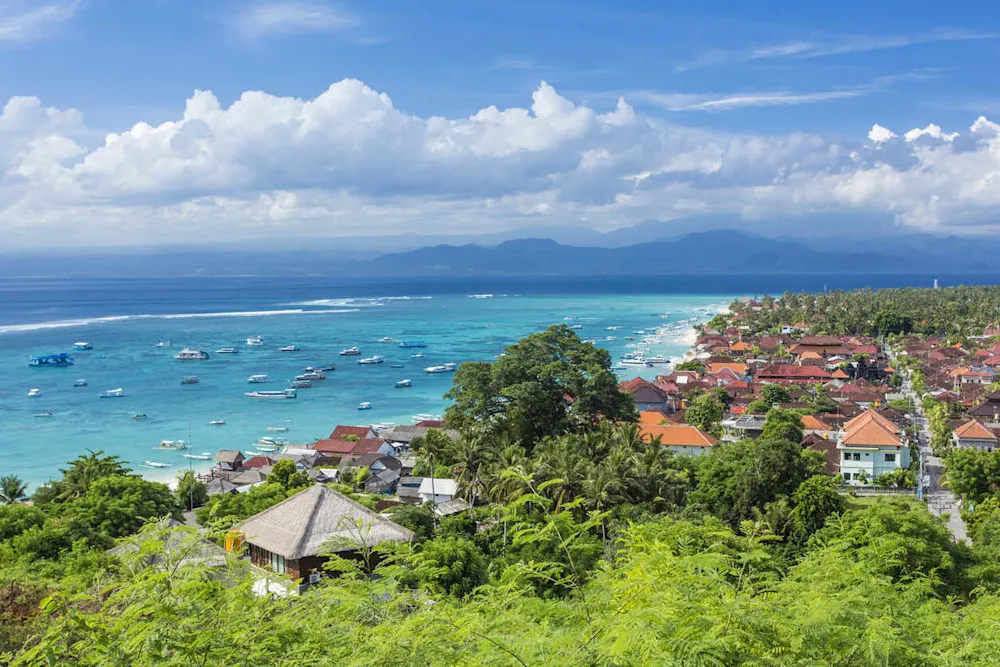
If the idea of azure-water-lapped islands, fewer tourists, and a quieter pace of life appeals to you, Nusa Lembongan might be just the place.
While technically not Bali proper, this tiny island is just a 30-minute boat ride away (with tickets ranging from $15 to $25) from several ports on Bali. At only 3.1 square miles, Nusa Lembongan offers postcard-worthy beaches, clear turquoise waters, and a laid-back island lifestyle. With a permanent population of just 6,000 people, it feels a world away from the hustle of Ubud or Bali’s more developed coastal towns.
There are fewer amenities here, of course. Hop off the boat and you’ll likely be flagging down a golf-cart taxi to reach your accommodation. But for many, that’s part of the charm—no traffic, no honking horns, just peace and quiet.
Dining options are more limited than in places like Ubud, but still diverse and affordable. You’ll find seafood spots, traditional Indonesian fare, organic cafés, and a few international choices. Long-term rentals are not as plentiful here and prices vary widely, but you can expect to pay around $400 for a room or small cabin, and $1,500 or more for a luxury villa.
One of the biggest perks? Free access to incredible diving, surfing, and snorkeling spots—all within walking or golf-cart distance.
Cons to consider:
The slower pace is perfect for those looking to truly unplug while still enjoying a reasonable standard of living. However, limited infrastructure means fewer expat-focused services and amenities. If you rely on modern conveniences or need regular access to city comforts, Nusa Lembongan may feel a bit too remote.
3. Sidemen: Mountains, Waterfalls, and Tranquility Off the Beaten Track

As one of the increasingly few places in Bali that hasn’t been overtaken by large-scale tourism, this next option is so special I almost didn’t want to share it. Sidemen is one of my favorite places on the island—a peaceful village and district tucked among rolling hills, waterfalls, and lush rice terraces. It’s so under-the-radar that even an Indonesian friend of mine had never heard of it.
Located about 30 miles from the international airport and nestled in the shadow of Mount Agung—Bali’s highest volcano—Sidemen is the kind of place where time slows down. Walk through town and you’ll be met with warm smiles and children waving as you pass.
Not much happens here, and that’s exactly the point. Sidemen tends to shut down after dark. During my stay, the restaurants were limited in number but surprisingly excellent—some of the best warung and upscale meals I had on the entire island. Just don’t expect to dine late; after 9 p.m., most spots have already closed. That leaves you with a kind of serenity that’s hard to find elsewhere—where the stars truly shine, and quiet evenings on the veranda become your new routine.
Traffic is minimal, with scooters and small vehicles the main forms of transportation. They’re essential to reach shops and food options, though everything remains extremely affordable. You can rent a villa here for as little as $250 per month.
If you’re looking for a peaceful, affordable retirement in a truly beautiful setting, Sidemen is hard to beat.
Cons to consider:
Sidemen’s remoteness means there’s little in the way of nightlife and fewer modern conveniences. If you need regular access to city amenities, this may not be your best fit. That said, with larger towns just a short drive away, it’s still possible to enjoy a tranquil lifestyle without feeling completely cut off.
4. Gili Islands: Tropical Island Life with a Bohemian Flair
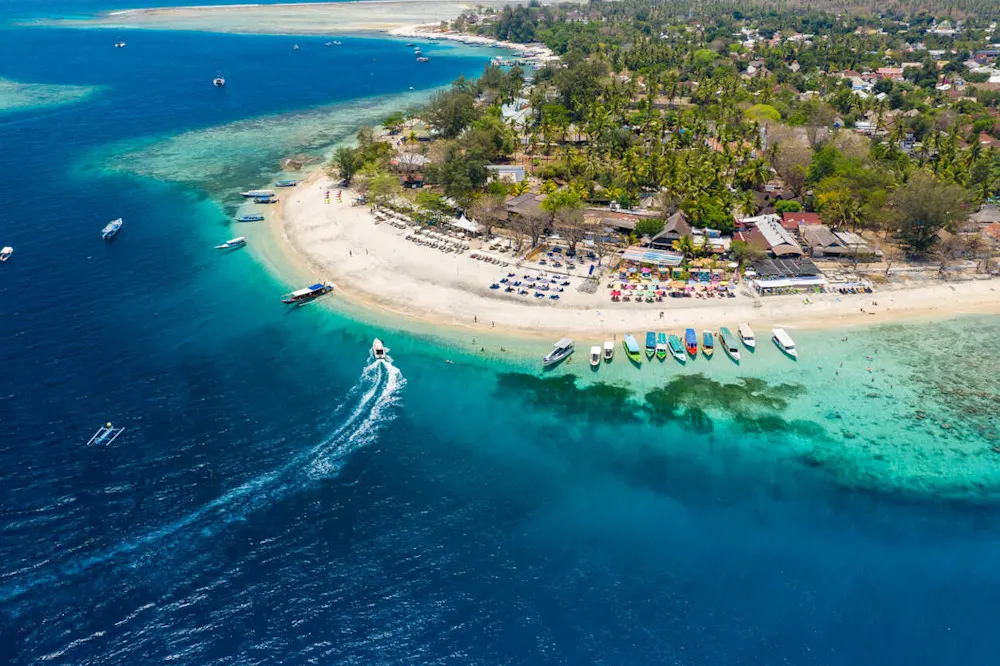
No cars, no chaos—just turquoise waters and island breezes. That’s the essence of the Gili Islands. Technically part of Lombok, this trio of tiny islands—Gili Trawangan, Gili Air, and Gili Meno—is easily reached from Bali by boat (roughly two to three hours, depending on your departure point) and offers an idyllic, castaway lifestyle with just enough creature comforts.
Picture this: swimming with sea turtles in the morning, fresh grilled fish for lunch, and watching the sunset with your feet in the sand. Life slows down here—and that’s the appeal.
Each island has its own distinct vibe.
Gili Trawangan (or “Gili T”) is the most vibrant, known for its beach bars, diving schools, and nightly seafood barbecues. It attracts a younger, party-seeking crowd, particularly Australians.
Gili Meno is the quietest and least developed—perfect for solitude and total relaxation.
Gili Air strikes a balance, with a laid-back but social atmosphere that appeals to many expats and honeymooners alike.
No motorized vehicles are allowed on any of the islands, so transportation is strictly on foot, by bike, or by horse-drawn carts that quietly tinkle down sandy paths.
Like much of Bali, the Gilis remain affordable for Westerners. Long-term rentals start around $300 for a basic bungalow, while beachfront villas with modern amenities can run $1,000 or more. Meals at local warungs cost as little as $3, with plenty of vegetarian and international options along the shoreline. Upscale dining ranges from $20 to $30 for a full meal.
Cons to consider:
The charm of the Gili Islands is their remoteness—but that also comes with trade-offs. Infrastructure is limited, Wi-Fi can be patchy, and healthcare is basic. Power outages and supply delays aren’t unusual. If you need consistent modern conveniences or easy access to medical services, the Gilis may not be the right fit. And while Gili T offers more in terms of amenities, it’s also much louder and more tourist-heavy.
5. Seminyak: Chic and Upscale Living
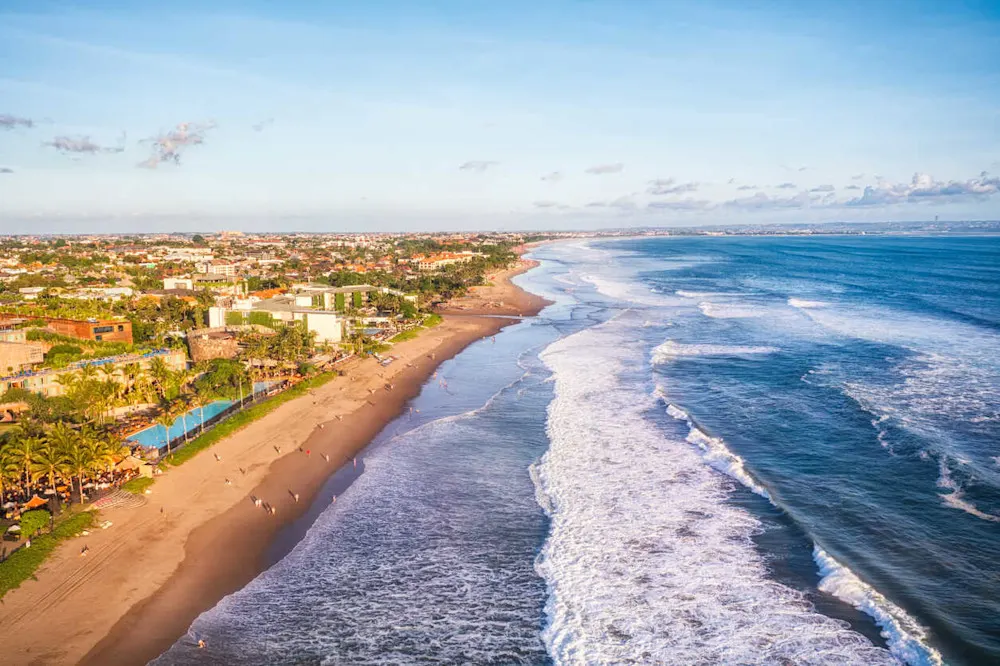
For those drawn to sun, style, and a touch of sophistication, Seminyak offers a vibrant yet polished slice of Bali life. Located on the southwest coast just north of Kuta, it has evolved into a cosmopolitan enclave—where beach living meets boutique elegance.
The vibe is hippie-chic, with spectacular sunsets and a variety of scenic beaches that draw visitors from around the world. More upscale than many of Bali’s other beach towns, Seminyak is lined with art galleries, high-end spas, designer boutiques, and some of the best restaurants and cafés on the island. Whether you’re sipping a turmeric latte at a trendy café, listening to live music at a rooftop bar, or indulging in a Sunday brunch at a beachfront resort, Seminyak exudes a glossy, international feel—while still offering glimpses of Balinese charm down quieter side streets.
If you prefer a more energetic atmosphere with plenty of amenities, this may be your ideal spot. Popular with younger expats, entrepreneurs, digital nomads, and families who want comfort and convenience, Seminyak has it all: yoga studios, international schools, coworking spaces, and expat meetups.
That lifestyle does come at a higher price. One-bedroom apartments start around $700 per month, while stylish villas range from $1,000 to $2,500+ depending on location and features. Dining out is also pricier than in Ubud or Sidemen, but still significantly more affordable than in the West. Expect to pay around $10–$20 for a meal at a mid-range restaurant, with budget options available if you know where to look.
For those who enjoy luxury living and beach life—while still having cultural experiences nearby—Seminyak has a lot to offer.
Cons to consider:
With popularity comes congestion. Traffic is common, especially during high season, and overall costs are higher than in other parts of the island. While Seminyak excels in lifestyle and luxury, it may not be the best fit for those seeking quiet, solitude, or a deeper cultural immersion.
The World’s Best Retirement Havens for 2026
The World’s Best Retirement Havens for 2026
24 Countries Compared, Contrasted, Ranked, and Rated. You don’t have to be rich to enjoy a pampered retirement, you just need to know where to go. With our 35th Annual Global Retirement Index, our experts hand you a detailed roadmap. Details—and a Special Offer—Here

By submitting your email address, you will receive a free subscription to IL Postcards, Overseas Dream Home, The Untourist Daily and special offers from International Living and our affiliates. You can unsubscribe at any time, and we encourage you to read more about our Privacy Policy.
2 Places to Avoid in Bali
1. Kuta: Crowded, Lively, and Not for Everyone
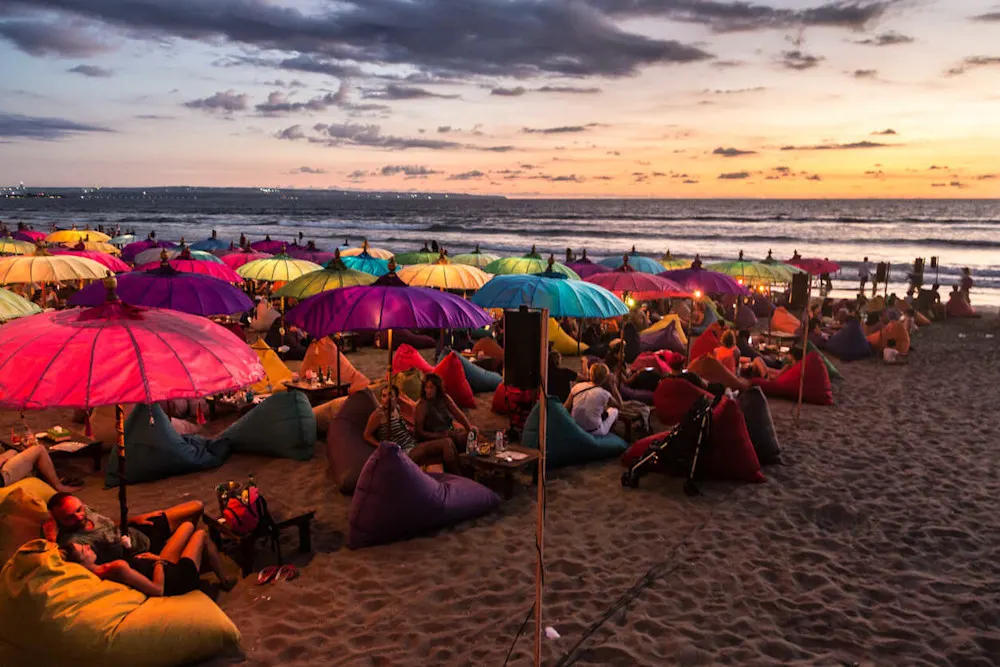
While some still love Kuta, in my view, it’s one to skip. Once a laid-back surf town beloved by backpackers, Kuta has evolved into Bali’s most chaotic and commercialized hub. It was one of the first places on the island to embrace large-scale tourism—and it shows. Today, it’s crowded, noisy, and relentlessly busy. Loud music, aggressive touts, traffic jams, and a 24/7 party atmosphere dominate the scene.
The beach, once a standout, is now flanked by fast food chains, souvenir shops, and a revolving door of party-seeking tourists. Petty theft and tourist scams are on the rise, adding to the unease.
If you’re in your early 20s and in search of nightlife, it might be worth a quick stop. But for expats, families, or anyone craving a more peaceful, authentic, or community-oriented lifestyle, Kuta is best avoided.
2. Jimbaran: Overpriced and Overdeveloped
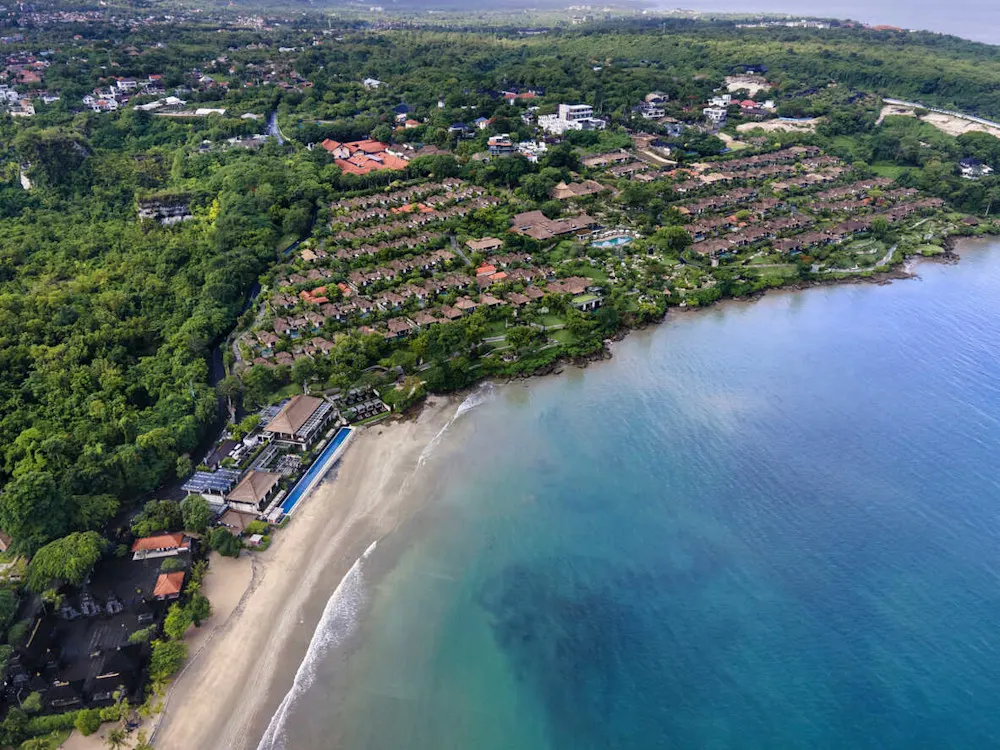
For those who visited Jimbaran years ago, its appearance on this list may come as a surprise. Once a sleepy fishing village known for its seafood barbecues and peaceful bay, Jimbaran has seen rapid, upscale development in recent years—becoming a hotbed for luxury resorts and large-scale construction.
Yes, the sunsets are stunning (especially from resort viewing decks), but the rest of the area can feel curated for tourists rather than livable for residents. Property prices are high, the expat community is more scattered and transitory compared to places like Ubud or Canggu, and local charm is increasingly hard to find outside the resort walls. Dining is noticeably more expensive here, and daily life feels more hotel-based than neighborhood-oriented.
That said, your mileage may vary. My partner loved Jimbaran for its luxe vibe, scenic coastline, and resort-style convenience. For me, it lacked the soul, local flavor, and sense of connection I seek when living or traveling abroad.
And that’s the key takeaway: while this guide is based on personal experience and what’s proven popular with many expats, everyone’s ideal lifestyle is different.
What to Know Before You Go
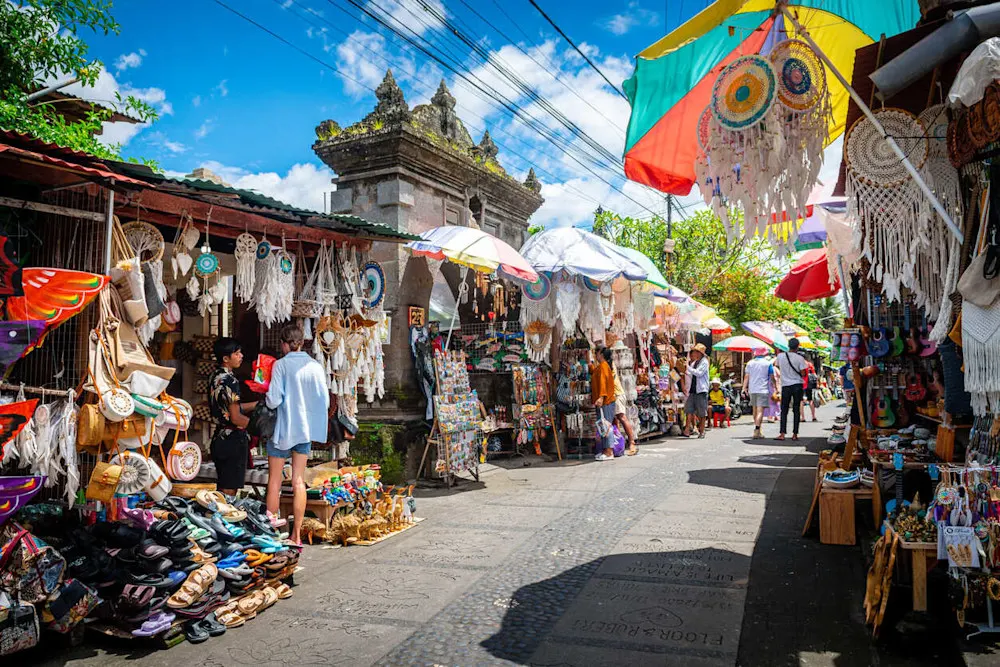
Tourism and Local Tolerance
While the warmth, magic, and welcome of Bali remain constant, it’s fair to say that tourism—especially influencer-fueled tourism—has had an impact on this truly one-of-a-kind island. Locals are among the friendliest I’ve encountered anywhere in the world, and many are excited to share their culture, cuisine, history, and beliefs with visitors.
That said, disrespectful behavior is not tolerated. I heard firsthand stories of tourists being arrested at sacred sites for inappropriate acts, and even a few who were deported for crossing boundaries. If you’re looking for a place where “anything goes,” Bali may not be the right fit. But if you’re someone who appreciates cultural richness, tradition, and respect for local values, Bali will reward you deeply.
Real Estate Considerations
If you’re hoping to purchase property in Bali, it’s important to understand that the process can be more complex than in many other retirement destinations. Foreigners are not allowed to directly own freehold property. However, there are legal pathways to secure long-term use and control—typically through leasehold agreements, which commonly run for 25 to 30 years and can often be extended.
If buying in Bali is something you’re seriously considering, do your due diligence: research your rights, and always work with a reputable lawyer and licensed real estate agent who understands the local regulations and can guide you safely through the process.
The World’s Best Retirement Havens for 2026
The World’s Best Retirement Havens for 2026
24 Countries Compared, Contrasted, Ranked, and Rated. You don’t have to be rich to enjoy a pampered retirement, you just need to know where to go. With our 35th Annual Global Retirement Index, our experts hand you a detailed roadmap. Details—and a Special Offer—Here

By submitting your email address, you will receive a free subscription to IL Postcards, Overseas Dream Home, The Untourist Daily and special offers from International Living and our affiliates. You can unsubscribe at any time, and we encourage you to read more about our Privacy Policy.
